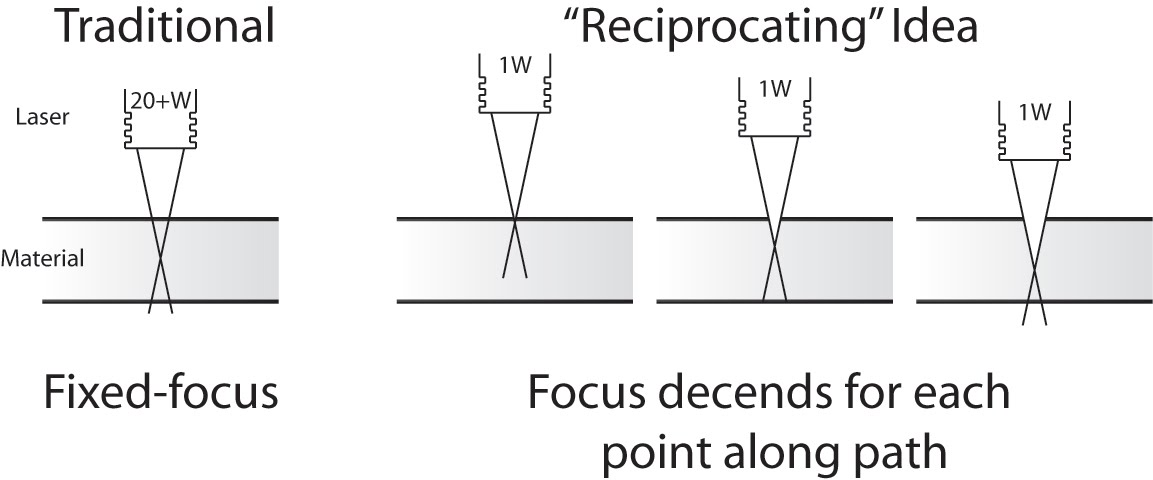Peter Jansen’s latest post about selective laser sintering (SLS) is nothing short of amazing. Most of his posts on the RepRap Builders blog posts deal with his adventures and research into SLS fabrication – basically directing a laser over a bed of powder to fuse powder in successive layers into a 3D object. Since the object is being created in a bed of powder and any new layer is supported by the powder above it, the powder print media becomes it’s own support material.
His latest post diverges from his adventures with SLS 3D printing and details his efforts at building a DIY laser cutter. His idea is for a “reciprocating laser” which would change the focal length or the height of the laser above the material being cut. Peter points out that commercial high power laser cutters essentially brute force burn through the entire depth of the material to be cut. They’re so powerful that it doesn’t matter that the laser is out of focus and “cooler” at different depths.
He has demonstrated a proof of concept using much lower power laser to cut material by lowering a much lower power laser as it cuts material. The downside is that the lower power laser requires a much longer time to burn through the material – having to hit the same area several times at different depths to cut all the way through. His proof of concept setup was about the size of a CD/DVD drive – since CD/DVD drives, motors, and housing provided most of his building materials. So far he’s been able to burn through most of two CD case backs – about 2mm together. He’s hoping to push it to cut thicknesses up to 3.0mm to 4.5mm.
The incredibly small size of his setup means that it can only very small pieces of material. However, this gave me two ideas:
- If the low power lasers are so cheap, why not install multiple lasers at different focal lengths?
- If the entire setup is that small, what about making the entire setup mobile? 1 Think hexapod CNC mill. If a laser cutter wheeled or hexapod robot was as small as a CD drive, you could conceivably just take out a large sheet of acrylic or thin plywood, set the robot in the dead center, and let it go. 2
- This reminds me of one of my favorite sayings. “If Mohammed won’t go to the mountain, the mountain must come to Mohammed.” [↩]
- The robot could stay oriented in any number of ways. You could draw a grid on the material, the material could have a thin paper coating with LeapFrog style micro-dots that told the robot it’s location, you could project a grid onto the material with light or guide it with another laser like a laser guided missile. [↩]


That hexapod cnc is so cool because it is simultaneously awesome and terrifying nightmare material.
Having tried laser cutting with low-power laser diode myself, I would have to say that moving the laser to change the focus point is impractical. The cutting is best (quality of the edge, especially) when you’re cutting the entire depth of the material in one go and move continuously alongside the cutting path. As soon as you stop the horizontal movement for any reason (to lower the laser in this case), the beam starts to melt too much material and the point where you’ve stopped starts looking like a lunar crater. The longer you stay, the wider the crater. And it does not necessarily help in cutting, either, because the material start to melt (if it’s melt-able at all, of course) and droop down to the bottom of the “crater” where the laser has to do additional work of heating/evaporating it again.
I have also done cutting in several passes by lowering the focal point with each pass. But that did not help much either – by the time you come back for another pass, the material has cooled down and (important in my case) has compacted into a solid mass as opposed to the original foam which is relatively easy to cut.
In any case, I think that the idea to use multiple low-power lasers with different focal points has its merit. I was thinking about something similar myself although I was going to try and combine different color lasers to assist with cutting different color materials (important for low-power lasers).
But I think it should also be possible to use an optical splitter/combiner to create one beam from 3-4 laser diode sources, each with slightly shifted focus so that none of the lasers actually physically move, just their beams are most concentrated at different depths of the cut. At least in theory, it should be possible, anyways. Because in practice you’re probably going to end up wasting too much of the power (what little was available in the first place) in the splitter and the additional optics. Also, the lasers are cheap but a good quality splitter will be very expensive.
Anyways, it’s an idea. I’m still experimenting with lower power cutting myself and may eventually end up with making the focus-shifted setup to see how it works.
BTW, it’s worth noting that this type of combining low power laser diodes to create a powerful source has already been done. Many high-power solid state lasers (20W+) used in fiber optic telecoms are, in fact, assemblies of smaller laser diodes with their beams combined by prisms. They go through great pains to keep their focuses in the same place though. In our case we’ll have to deliberately misalign them. Anyways, I just wanted to say that it’s possible.
Good luck!
E-Nick